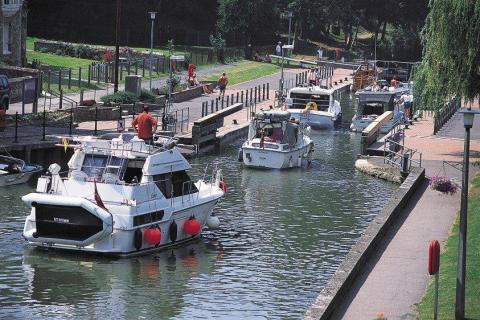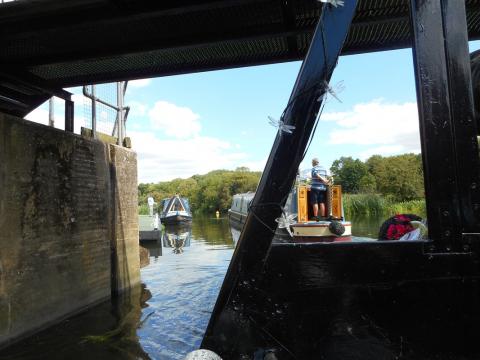Environment Agency seeks inflation-busting licence increase
July 2018 - Boaters on the The Thames, the Medway and the East Anglian Rivers are facing massive increases from the Environment Agency as it strives to get boat owners to pay more as the Treasury starves it of cash for navigations, as Peter Underwood reports.
The EA claims: “Each of our waterways currently receives significantly less income from boat registration charges than they spend on the services those charges should pay for. These charges contribute to our overall aim of keeping our waterways open and safe for use by both recreational boaters and those who rely upon them for their business. At the moment, across all our waterways, boat registration charges only contribute 25% of the total amount spent on the operational services.”
By way of contrast when the Canal & River Trust hiked its licence fees by 2.5% it said: “… the proportion of income from boaters has reduced from 19.9% to 18.3% of total income.”
C&RT, as it never ceases to tell us, looks after 2,000 miles of waterways and has 172 boats registered for each mile. The Environment Agency is the second largest Navigation Authority with 620 miles of inland waterways. It has 143 boats registered for every mile.
The increases proposed are the same the price hikes this year. That means for three years running boaters on the River Thames will see charges rises by 5.7% every year, those on Anglian Waterways will see a 7.5% hike every year and the unfortunates on the Upper Medway face a 10% rise every year.
According to the EA the price hikes – putting the costs up by nearly a third over three years - reflects ‘the significant gap between existing levels of income from boat registration charges on each waterway and the cost of providing the services which these charges pay for’.
It’s customer briefing goes on: “Each of our waterways currently receives significantly less income from boat registration charges than they spend on the services those charges should pay for. These charges contribute to our overall aim of keeping our waterways open and safe for use by both recreational boaters and those who rely upon them for their business. At the moment, across all our waterways, boat registration charges only contribute 25% of the total amount spent on the operational services.”
However, this is largely an exercise in getting boaters to pay proportionately more. EA waterways also receive income from other sources, mainly through Government grant-in-aid funding and from a range of boating-related commercial activities.
The problem is not that boaters haven’t been paying their fair share, but that navigation is way down the list of priorities for the government. As the EA briefing admits: “However, for a number of years the overall funding position has been declining, with impacts on our standards of service and the condition of our navigation infrastructure and facilities.”
It claims to be ‘working hard to address this situation through a range of activities’, but it all seems to have been too much and the Agency says: “We were going to consult on a new charging scheme and 5-year charging plan this year. However, this work is significantly more complex than we initially thought.”
So boaters won’t get a chance to look at any proposed new structure, instead the EA will implement this year's percentage increases for the next 2 years.
The Agency claims it is being fair in shifting the burden onto boaters, saying: “We are keen to invest the time now to make sure our charges are fair, transparent and linked more closely to the cost of the service we provide for boating customers.”
It says it will continue to develop ‘longer-term plans to make our navigations more financially sustainable, involving our customers in shaping this work’.
It also asserts: “These proposals are the minimum increases necessary to sustain a safe and efficient operational service. We think these are reasonable given the gap between the cost of the services, and the income we currently receive from charges.
However many boaters, including the Inland Waterways Association see the EA as neglecting vital waterways, especially its Anglian waters and even the Agency admits: “The extent to which activities are carried out on each waterway varies substantially. Influencing factors are budget and people; geography and waterway characteristics; customer need and expectation; popularity and use of the waterway; historic custom and practice.”
There are around 8,700 powered boats on the River Thames, over 4000 on the Anglian Waterways and 700 on the Upper Medway, that’s without Gold Licence holders and other visitors from the C&RT navigations.
The increases will mean that over two years a medium sized private powered boat would see an increase of £36.77 on the River Thames, £57.54 on Anglian Waterways and £52.71 on the Upper Medway.
The increases may be difficult for boaters but benefit to the EA is not exactly earth shattering with additional income from boat registration charges of £450k in 2019 to 2020 and £480k in 2020 to 2021.
The longer term consultation, when it arrives has uncanny echoes of C&RT’s licensing consultation which ended up with the Trust around 5% better off, despite promises it would be revenue neutral.
The EA says: “As part of our future strategic review of navigation charges we want to introduce changes that our customers have told us through consultation they wish to see, bringing more:
• consistency
• certainty
• flexibility
• fairness
• ways to pay
We will also consult further to build on and refine our understanding of the feedback we have already received.”
It insists: “Reviewing our charges is just one part of a much wider ongoing programme to make our waterways more financially sustainable.
“We are launching new commercial activities as well as maximising income from existing ones. To do this we are seeking additional flexibility from government to allow us to be more innovative in how we establish new income streams to spend across our waterways.
“We know our boating customers are keen for us to do more to secure revenue from all those who benefit from the waterways. We intend all of our project work to boost the income we receive from sources other than our boating customers, whether in the short, medium or long term.”
The Agency cannot resist ending with a dire warning: “We believe anything less than the increases we propose will require us to reduce service levels, or investment in our assets which could result in more frequent or more serious breakdowns of those assets and potentially closures.”
Photos: (1st) Allington Lock on the Medway, (2nd) Thames lock approach, (3rd) Navigating the Nene.








